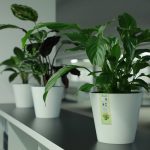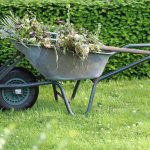As a busy freelancer, you’ll love low-maintenance plants that thrive on neglect. Consider the Snake Plant for its striking leaves or Pothos for its easy-going nature. ZZ and Rubber Plants offer stylish greenery with minimal care. Spider Plants brighten your space, while Peace Lilies purify the air with elegance. These plants aren’t just hassle-free; they also boost productivity and creativity. Stick around to discover more about cultivating the perfect workspace with these greens!
Table of Contents
Key Takeaways
- Snake Plant: Thrives in various lighting and requires minimal watering, making it perfect for busy freelancers.
- Pothos: Adapts to different light conditions and only needs water when the soil is dry, ensuring low maintenance.
- ZZ Plant: Tolerates neglect and low light, ideal for freelancers who may forget to water regularly.
- Spider Plant: Resilient and easy-going, it adds vibrancy to workspaces while requiring minimal care.
- Peace Lily: Enhances productivity with its elegant blooms and purifies the air, needing only occasional watering.
Snake Plant
If you’re looking for a reliable low-maintenance plant, the Snake Plant is an excellent choice.
This hardy plant thrives in various lighting conditions, from low light to bright indirect sunlight. You won’t need to worry about frequent watering either; it prefers to dry out between waterings, making it perfect for your busy lifestyle.
Just check the soil every few weeks, and if it feels dry, give it a drink. Plus, the Snake Plant purifies the air by removing toxins, creating a healthier workspace for you.
Its striking, upright leaves add a touch of elegance to any room without demanding much attention. With minimal care, you can enjoy the beauty and benefits of this resilient plant for years to come.
Pothos
Pothos is a fantastic choice for freelancers who want a hassle-free plant.
It thrives in various light conditions and only needs watering when the soil dries out.
Plus, propagating Pothos is a breeze, making it easy to expand your collection with minimal effort.
Ideal Light Conditions
Although Pothos thrives in a variety of light conditions, it performs best in bright, indirect sunlight.
This plant can adapt to low-light environments, making it perfect for your busy freelancer lifestyle. However, if you want your Pothos to grow lush and vibrant, place it near a window where it can receive filtered light.
Avoid direct sunlight, as it can scorch the leaves and hinder growth. If you notice the leaves turning yellow, it might be a sign that it’s getting too much light. Conversely, if the plant becomes leggy, it could need more brightness.
Watering Needs Simplified
How often should you water your Pothos? Typically, you should water your Pothos every 1-2 weeks, but it really depends on your home’s humidity and temperature.
Check the top inch of soil; if it’s dry, it’s time to give your plant a drink. Overwatering can lead to root rot, so be cautious.
Pothos are forgiving, so if you forget occasionally, they’ll bounce back. During the growing season, you might need to water more frequently, while in winter, you can cut back.
Just remember to use a pot with drainage holes to prevent standing water. With minimal effort, you’ll keep your Pothos thriving, making it a perfect companion for your busy freelance lifestyle.
Propagation Made Easy
If you’re looking to expand your collection of Pothos or share the joy of plants with friends, propagating your Pothos is a breeze.
Start by cutting a healthy vine with at least two to three leaves. Make the cut just below a node, as this is where roots will form.
You can propagate in water or soil; both methods work well. If you choose water, place the cutting in a glass, ensuring that the node is submerged. Change the water every few days.
For soil propagation, plant the cutting in a small pot with well-draining soil. Keep it moist but not soggy.
In a few weeks, you’ll see roots developing, and soon you’ll have new Pothos plants to enjoy!
ZZ Plant
The ZZ plant is perfect for freelancers who want a stylish yet low-maintenance option.
It thrives in a variety of conditions, making it easy to care for.
You’ll appreciate how little attention it needs while still brightening up your workspace.
Care Requirements Overview
Although you may think that all plants require constant attention, the ZZ plant (Zamioculcas zamiifolia) thrives on neglect, making it an ideal choice for busy freelancers.
This resilient plant can tolerate low light conditions and doesn’t need frequent watering; in fact, overwatering can lead to root rot. You only need to water it when the top inch of soil feels dry, typically every 2-3 weeks.
ZZ plants prefer well-draining soil and can adapt to a variety of pot sizes. Fertilizing isn’t necessary, but a balanced houseplant fertilizer once or twice a year can promote growth.
With minimal care, the ZZ plant adds vibrant greenery to your workspace without demanding your time and attention.
Ideal Growing Conditions
To guarantee your ZZ plant thrives, it’s important to provide the right growing conditions. These hardy plants prefer indirect light, so place them near a window but avoid direct sunlight. They tolerate low-light environments, making them perfect for freelancers who may not have ideal lighting.
Water your ZZ plant sparingly; let the soil dry out completely between watering sessions. Overwatering can lead to root rot, so less is more! As for temperature, they enjoy a range from 60°F to 75°F (15°C to 24°C).
Here’s a quick overview of their ideal conditions:
| Light | Watering | Temperature |
|---|---|---|
| Indirect light | Sparingly | 60°F-75°F |
| Low light | Allow to dry | (15°C-24°C) |
Spider Plant
If you’re looking for an easy-going plant to brighten up your workspace, the Spider Plant is an excellent choice.
Known for its resilience, this plant thrives with minimal care, making it perfect for your busy lifestyle.
Here are three reasons why you should consider adding a Spider Plant to your home office:
- Air Purification: Spider Plants effectively remove toxins from the air, improving your workspace’s air quality.
- Low Light Tolerance: They adapt well to various lighting conditions, so whether your desk is near a window or in a dim corner, they’ll thrive.
- Propagation: They produce “pups” or baby plants, allowing you to easily propagate and share with friends or expand your collection without hassle.
With these traits, the Spider Plant is a fantastic companion for any freelancer.
Peace Lily
When you want a touch of elegance in your workspace, the Peace Lily is a perfect choice.
With its lush, green leaves and striking white blooms, it not only beautifies your environment but also purifies the air. This plant thrives in low light, making it ideal for your home office.
You won’t have to worry about constant watering, as it prefers to dry out slightly between waterings. Just give it a drink when the soil feels dry to the touch.
Additionally, the Peace Lily is known for its ability to tolerate neglect, so it’s perfect for your busy lifestyle.
Embrace this low-maintenance beauty and enjoy a serene atmosphere that boosts your productivity and creativity.
Aloe Vera
Aloe Vera stands out as a versatile and resilient plant, making it an excellent addition to any freelancer’s workspace. This succulent thrives on neglect, requiring minimal care while providing numerous benefits. You’ll appreciate how it can enhance your environment without demanding much time.
Here are three reasons to contemplate Aloe Vera:
- Air Purifier: It helps filter out toxins from the air, promoting a healthier workspace.
- Medicinal Properties: The gel inside its leaves is perfect for soothing minor burns and skin irritations.
- Low Water Needs: Water it only when the soil is dry, making it ideal for your busy schedule.
With Aloe Vera, you can enjoy the perks of greenery without the hassle!
Cast Iron Plant
The Cast Iron Plant is another fantastic option for freelancers looking to liven up their workspace with minimal effort.
Known for its hardy nature, this plant can thrive in low light and withstand neglect. You won’t need to worry about frequent watering; just let the soil dry out between drinks. Its lush, dark green leaves add a touch of elegance without demanding much care.
Plus, it’s resistant to pests, making it perfect for busy environments. Place it on your desk or a shelf, and it’ll enhance your space while you focus on your work.
With the Cast Iron Plant, you’ll enjoy a vibrant atmosphere without the hassle of high maintenance. It’s truly a freelancer’s best friend!
Rubber Plant
If you’re looking to add a touch of greenery to your workspace without the fuss, the Rubber Plant is an excellent choice.
This hardy plant thrives in various conditions, making it perfect for busy freelancers. Here’s why you’ll love it:
- Low Light Tolerance: The Rubber Plant can adapt to lower light levels, so you don’t need to place it by a window.
- Minimal Watering: Water it only when the top inch of soil feels dry; it’s forgiving if you forget occasionally.
- Air Purifier: It helps improve air quality, making your workspace healthier and more pleasant.
With its glossy leaves and minimal care requirements, the Rubber Plant is a stylish and practical addition to your office space.
Frequently Asked Questions
Can These Plants Survive in Low Light Conditions?
Yes, many low-maintenance plants thrive in low light. Consider options like snake plants or pothos. They’re resilient and adapt well, so you won’t have to worry about constant sunlight or complicated care routines.
Are Any of These Plants Toxic to Pets?
While your home flourishes with greenery, it’s essential to guarantee your furry companions stay safe. Some plants can be toxic to pets, so double-check each species before bringing them into your haven. Knowledge is power!
How Often Should I Fertilize These Plants?
You should fertilize your plants every 4 to 6 weeks during the growing season. In winter, reduce feeding to once every 8 weeks. Always follow the specific instructions on your fertilizer for best results.
What Is the Ideal Temperature for These Plants?
The ideal temperature for most low-maintenance plants is between 65°F and 75°F. You should avoid exposing them to extreme cold or heat, as it can stress the plants and hinder their growth.
Do These Plants Need Repotting Regularly?
Most low-maintenance plants don’t need frequent repotting. You’ll typically find they thrive for years in their original containers. Just check for root-bound signs, and consider repotting only when necessary to promote healthy growth.




